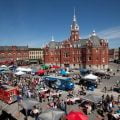Just shy of two centuries ago (1828), the Canada Company began surveying Huron Road, part of which included an area where William “Tiger” Dunlop became the first European to plant his surveyor’s stakes in what would become Stratford, Ontario.
But as was typically the case in those early days, it took a while before Stratford really began to take shape. Four years after Dunlop’s arrival, Thomas Mercer Jones, a Canada Company director, arrived and gave a picture of William Shakespeare to William Sargint, owner of the Shakespeare Hotel. Perhaps out of a desire to make their surroundings feel like the old country or perhaps out of a love for the Bard, they named the village Stratford, and the Little Thames creek was renamed the Avon River.
What has emerged since is much more than a town that celebrates great theatre. Surrounded by some of the best farmland in southern Ontario and serving as the region’s railway hub and county seat, Stratford is also known for its architecture, parks, fine food and elegant surroundings. And beyond the Stratford Festival, there is also a thriving arts scene, offering everything from music to painting to sculpture.
About a 90-minute drive from Toronto, Stratford is an easy destination as a day trip from the big city, and it also serves as a bedroom community for people who still work in the urban sprawl. It’s a town we’d gladly live in, and one that merits return visits to fully appreciate its charms.
In many ways, a visit to Stratford and the surrounding Perth County has a bit of a time travel element to it. While other towns have modernized with the times, the folks in Stratford have seen fit to preserve what they have, with many of the buildings maintaining their 19th-century style and charm. Meanwhile, the nearby town of Milverton is home to one of the largest Amish communities in North America, making the sight of horses and buggies out on the sideroads commonplace.












